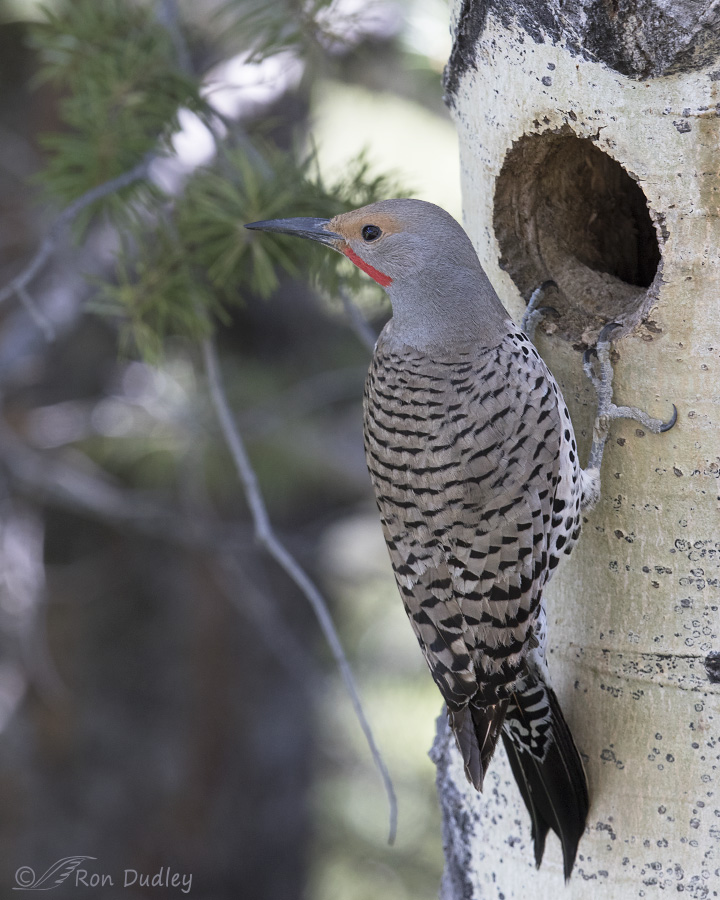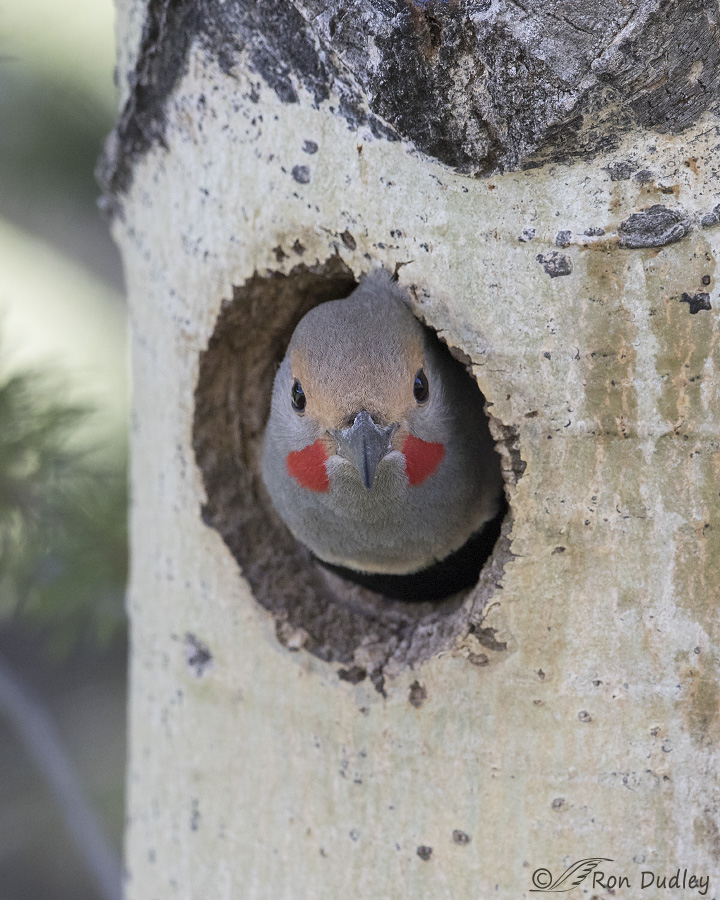I’ve always found Northern Flickers to be shy and elusive so being close to this male was a treat for me.
 1/320, f/9, ISO 800, Canon 7D Mark II, Canon EF 500mm f/4L IS II USM, not baited, set up or called in
1/320, f/9, ISO 800, Canon 7D Mark II, Canon EF 500mm f/4L IS II USM, not baited, set up or called in
I found him early last month at his nest hole in an aspen tree in Clark County, Idaho as he and his mate were preparing the cavity for an eventual family. This head turn allowed me to compose the image to include more habitat than just the tree and cavity opening and even though the setting is a little cluttered and the bird is in shade I do appreciate the habitat aspect of the image.
Northern Flickers use pre-existing nest cavities (rather than excavating new ones each year) more often than most other woodpeckers and these birds were refurbishing an older cavity.
 1/400, f/6.3, ISO 800, Canon 7D Mark II, Canon EF 500mm f/4L IS II USM + 1.4 tc, not baited, set up or called in
1/400, f/6.3, ISO 800, Canon 7D Mark II, Canon EF 500mm f/4L IS II USM + 1.4 tc, not baited, set up or called in
I like this shot because it’s different. The head-on view with the head raised allows us an unusual good look at both red malar stripes of the male. Due to lack of depth of field very little in the image is tack sharp except the front of the bird’s face but that helps to focus my attention on the bird – especially in this low light that tends to mute everything in the image.
As of last night the fire on Antelope Island had consumed 13,740 acres of the 28,000+ acre island and it’s only 35% contained. According to managers, wildlife has largely been able to avoid the immediate effects of the fire but it will have far-reaching implications for the island’s wildlife and birds for a long time to come.
There’s more information here if you’re interested.
Ron


Beautiful shots Ron. I like the 2nd one too. Saddened to hear about the fire. Hope they can contain it soon. We have one here too. I always worry about the wildlife. Let alone the beauty that is destroyed.
Thank you, Jean.
Love the perfection of that hole. Love, and am awed (again) at what ‘bird brains’ can achieve.
Yay for behavioural shots.
And my heart aches for all those affected by the fire. I so hope it can be controlled. Soon.
Yeah, the irony of the phrase “bird brains” in the context in which it’s usually used…
BTW, I’ve noticed that you often comment about 2 pm my time in Utah and have often wondered what time that is for you in Australia – so I finally looked it up. If I chose the correct time zone for you I think it’s 6 AM…?
As a special ed teacher, who loved science but specialized in LA, I always felt all math was unsolvable…the perfect roundness of these cavity entrance holes proves my point. What bird do you know that ever took math? I am keeping my fingers crossed that the wildlife on Antelope Island is OK…AND THAT THE WHOLE ECOSYSTEM CAN BOUNCE BACK QUICKLY AND COMPLETELY. Just thinking about the potential devastation is too hard to bear….
Patty, I actually thought of you when I was composing this post because I know that you often mention the roundness of the nest entrances. Some of them almost look like the birds used a compass as they were drilling them.
What gorgeous shots of this Northern Flicker. As much as I love your photography (and I LOVE it!), I love the behavioral aspects more. So much to learn among such diversity.
As for the fire, I’m just heartsick…it’s one thing to lose homes, and while that’s hideously heart wrenching, losing habitat/wild lives is even worse (in MY world). And yes, there’s the issue of regeneration and renewal, but also the death and destruction in the now.
Thank you, Laura. I’m glad you enjoy behaviors as I do.
Beautiful shots Ron, great views!
Is there any possibility after the fire is controlled or burns itself out to import bales of grass for the bison/antelope?
There must be a way to solve this problem rather than killing off the wildlife. It may be a short term solution, but something is better than not trying to save them. Plus it just isn’t the them there are other wildlife that depend on both Bison and Antelope. It seems to me this is a huge catastrophe in the making.
I have no idea what they might decide to do about the lack of forage, Dick. Some difficult decisions to be made, that’s for sure.
I love the head on shot!
Antelope Island is such a unique habitat. I too worry about the wildlife’s near future for food. The grass will be back next spring but meanwhile that is a lot of lost forage. Will the birds be able to fatten up before migrating. Will they move near by and find food? They will have to feed the bison or move them. I am glad I am not in management of the island right now . I would be pulling my hair out. I did find an interesting map on a websight that shows where the fire is if you are interested. http://wildfiretoday.com/
That is an interesting map, April. Thanks for the link.
I wouldn’t want to be Jeremy Shaw (park manager) over the next days and weeks. He has lots of tricky management decisions to make.
Great site! See the idiots with the drones are out in MT also. 🙁
Wonderful Ron! How I would love to see a nesting cavity!
Charlotte
They can be very difficult to find, Charlotte, but once you learn a few tricks it becomes much easier.
Beautiful photo’s of the Northern Flicker. Fire is bad news and 35% containment isn’t much particularly with the temps and wind. 🙁
Thank you, Judy.
Great images of a beautiful bird Ron. Flickers are so colorful, fairly common, and yet I find them very hard to photograph. I love the second image and the detail you can see on its feathers.
Hoping the fire on Antelope Island is quenched by rain very soon, like today! I hate to say this, but with all the big forest fires we have experienced in New Mexico over the past 15 years, it seems like rainstorms are the only thing that really put out these monster fires. Burning back fires, bulldozing, aerial attacks, etc are helpful, however nothing seems to beat a really good downpour on the fire. So, wishing a very cold and rainy weather pattern for you.
Ed, rain just isn’t going to happen. And it’s supposed to be over 100 degrees for the next week.
If they don’t get it quenched soon it will have utilized all the fuel available and just burn itself out – after all, the fire really can’t get off the island.
Burro owls!!!!!!!!!!
Yes, lots of Burrowing Owls.
No, definitively you are not “the Lone Ranger on that one”. In fact I like it very much.
Being different does not necessarily means a bad thing. In this case it allows us to see details that otherwise would be missed.
Sad to hear about the fire. Hope everything turns out for the best.
Did you find out what was the problem on the 7D Mark II?
“Did you find out what was the problem on the 7D Mark II?”
Not yet, Jorge. I spent a lot of time testing it before I could be (pretty) sure it was the camera and not the lens – intermittent problems are always hard to pin down. And now I’ve decided to contact a local repair shop and see if they can fix it before I send it to Canon if I have to. But Monday is a holiday around here (Pioneer Day) so I won’t be able to contact the shop until Tuesday.
Ohhhhh so sad!!!! About antelope island. Hope all the birds have fledged. Non of the swainsons here have fledged . Plus the ospreys just fledged 5 days ago. Soooo ??????are there swainsons there ? Theres water so there must be ospreys?
Marina, I’ve seldom seen Swainson’s Hawks on the island this time of year. And the lake is highly saline so it has no fish.
Good!!!! But have burro owls fledged yet???
I believe most have, Marina but I don’t know if all of them have.
Beautiful shots. I love the detail the close-ups provide and thanks for the update on the AI fire. Am really saddened by the loss of so much vegetation and its potential long-term effects on the wildlife. Not to mention the visual scar it’s going to leave.
I have so many questions about the future effects of the fire, Larry.
For example, since the carrying capacity of the island for bison is about 500 animals and most of the forage is now gone, what are they going to do with that many bison? They can’t get off the island to look for food so will they have to drastically cull the herd?
Then there’s the pronghorn…
I love both of these shots, but especially the second one because it is so unusual. I’m very sorry to hear about the fire on Antelope Island – had not previously heard about it. Fires are always devastating, even when they are a natural part of the ecology of an area. Hopefully both the plant and animal life will be able to recover quickly.
I’m glad that second image appeals to you, Susan. I thought I might be the Lone Ranger on that one…